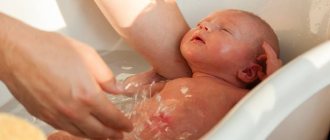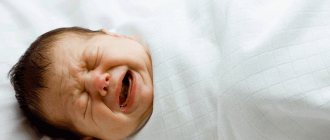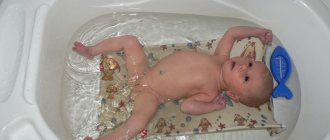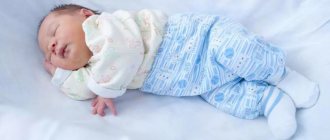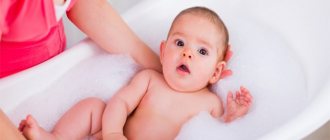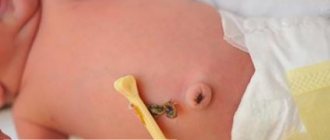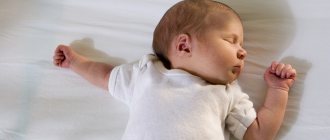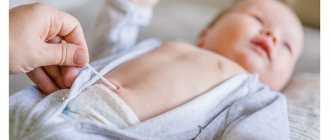When to bathe a newborn for the first time?
Previously, young parents were not allowed to bathe their baby in the bath until the umbilical wound had completely healed. But considering that healing sometimes lasts up to 2 weeks, and the lack of good cleansing of the skin can lead to irritation and inflammation, the timing of the start of water procedures has been revised. Today, according to the recommendations of pediatricians, you can start bathing a newborn the very next day after discharge from the maternity hospital. It is allowed to bathe babies whose umbilical wound has not yet completely healed, and even those whose umbilical cord has not yet separated. If bathing is postponed due to any circumstances, it is necessary to wipe the baby’s skin daily with a soft wet sponge or baby wipes. You should not bathe a baby only if he has a fever or other signs of illness.
General rules:
- Despite the fact that bathing is an integral part of hygienic care, you can only bathe your baby if he has no contraindications from a doctor and is completely healthy. It is recommended to take water procedures at approximately the same time in order to develop a habit in the child and maintain a daily routine.
Important! It is believed that the best time for bathing is before evening feeding.
- You can bathe newborns for no more than 10 minutes, because the water cools quickly, and low temperatures can be harmful. It is important to remember that the first few baths should be very short - up to 5 minutes, so that the baby gets used to this procedure.
- It is very important to control the temperature. So, the recommended water temperature for newborns is 36.5-37 degrees, and the air temperature should not fall below 22 degrees. And of course, drafts should not be allowed.
- As for whether it is necessary to boil water for bathing a newborn, this must be done if the umbilical wound has not yet healed.
- For redness and diaper rash, it is advisable to use herbal decoctions. Chamomile is best.
Important! If the baby is capricious and crying, he needs to be distracted, because the unpleasant emotion associated with bathing will last for a long time and each time you will have to calm him down first.
Bathing for babies should be turned into a kind of ritual in order to instill a love of water from an early age and not cause negative experiences.
What and where to swim?
Infants are bathed in a special baby bath until the umbilical wound is completely healed (up to 3-4 weeks). Based on the fact that the bath will not be needed for long, it is not rational to buy a very expensive one. When preparing for bath time, you should prepare a soapy baby bathtub, a soft terry towel or warm diaper, baby soap, bath product, a ladle of clean water for rinsing, and a water thermometer. You can bathe in the bathroom or in the room, wherever is more convenient for you. The main requirement for the room is the absence of drafts and an air temperature of about 24-25°C. You may be advised to put your baby in the water in a diaper: so that he does not get scared, so that he is warm, etc. However, as practice shows, the use of diapers is not justified. They only get confused and interfere with washing the baby well.
Conditions to be observed
You cannot wash a child with a fever in hot water. The optimal temperature for swimming is 37 degrees. By the way, when swimming in warm, but not hot water, the body cools down somewhat and the temperature may drop, which will lead to an improvement in the child’s condition.
If the temperature rises after vaccination, it is better to avoid taking a bath that day. If your baby is generally feeling well, you can give him a quick shower. In most cases, it is not recommended to wet the grafting site. But this recommendation specifically implies long-term contact with water, that is, if the child is put in the bathtub and plays there for a long time. If water from the shower just gets on the vaccination site when washing, nothing bad will happen.
You need to approach swimming with caution if the disease is accompanied by various rashes. With such symptoms, it is strictly forbidden to rub the rash with a washcloth, as this may contribute to the spread of infection. It is necessary to limit yourself to simply washing the body with water. It is advisable not to use detergents, as they can cause even greater irritation of the inflamed skin.
It is very important not to catch a cold in an already sick child during the bathing process. Therefore, during the procedure, you should close the windows to prevent drafts. After bathing, you need to carefully pat your child's body dry. Wet hair should be dried with a hairdryer. As a rule, there is no particular need to wrap your baby in a blanket after bathing, unless, of course, the room is cold.
So, whether or not to bathe a child when the temperature rises will have to be decided by the mother. The opinions of pediatricians on this matter are contradictory, although most modern doctors do not object to short-term washing. The mother needs to focus only on the child’s condition; if he is not feeling well, there is no need to drag him into the bath, such bathing will not bring any benefit, but will only upset the child. If the condition is relatively good, bathing can put the child in a positive mood and speed up recovery.
What should the water temperature be?
In order for the baby to be comfortable, the water temperature should be about 36-37°C. The water temperature should be measured with a water thermometer. You should not rely on your own sensations when determining the temperature with your elbow - the perception of temperature is individual. At a higher temperature, the baby may overheat, which, as a result, will manifest itself in the form of anxiety, sleep disturbances, or, conversely, lethargy. After 1 month, water procedures can already be combined with hardening. Then they begin to gradually reduce the water temperature by 1 degree every one or two weeks, bringing it to 28-30 °C.
Should I bathe with an unhealed umbilical wound?
This question comes up quite often. Some pediatricians allow bathing even with a clothespin on the navel, while others recommend refraining from taking water procedures until the umbilical cord dries out. Evgeny Komarovsky says that the choice is, of course, up to the parents. However, if the child is kept in acceptable living conditions, does not sweat, does not overheat, and does not get dirty, then nothing bad will happen to him if the baby does not bathe for a week or two.
For a long time, doctors advised bathing in water with a solution of potassium permanganate. However, you need to be extremely careful here; undissolved grains of potassium permanganate can cause serious burns on the delicate skin and mucous membranes of the baby. The solution should be pale pink and should be added to the water immediately before bathing. Komarovsky does not recommend potassium permanganate at all, since in small doses it is useless, and in large doses it is dangerous. It is better to replace it with infusion of succession.
Massage
A massage before an evening swim is a very useful and important procedure, says Evgeniy Komarovsky. During stroking and patting, the blood supply to the muscles and skin improves, and the benefits will be even more noticeable if you bathe the baby immediately after the manipulations. All parents, without exception, can master a simple massage. To do this, you do not need to enroll in special courses.
Komarovsky recommends doing a light and soothing massage before a bath. First, with baby cream, the mother can easily massage the hands (stroking and circular movements, this should be done with the thumbs). Then the legs are massaged in the same way. The tummy is stroked clockwise with the palm or fingertips. Then the baby is laid on the tummy and the back is gently massaged - first in circular and arched movements, and then with light pats.
Water temperature
Doctors recommend keeping the temperature at 37 degrees. It should be followed for at least the first 10-14 days. Then you can experiment - slightly increasing or decreasing the temperature (maximum - 1 degree).
Some parents try to warm up the bathroom in advance by bringing heaters into it (especially in cases where the first bath at home occurs in winter). Komarovsky does not recommend doing this. The temperature in the bathroom should be approximately the same as in the rest of the apartment (optimal values are 18-20 degrees), and overheating the air in the bathing room is harmful.
Such procedures will not cause any harm, but the general strengthening effect will be obvious, and in a cool bath it is more difficult for a child to fall asleep while bathing. However, you should not immediately rush to implement this recommendation. This should start gradually. The initial water temperature for a newborn is 34 degrees. In a month, a child can reduce it by 2 degrees - to 32 degrees, and bathing time can be increased from 15 minutes to half an hour. At two months, the temperature of cool water can be lowered to 28-30 degrees, bathing time is half an hour.
Komarovsky advises to take these figures rather conditionally. If a 1-month-old child calmly accepts swimming in water whose temperature is 24 degrees, there is nothing wrong with that. He sleeps soundly, rests well, worries less himself and allows his parents to sleep.
The first bath should not be very long. It is better to start with 3 minutes, the next day extend the procedure to 5 minutes, then add a little more time. Komarovsky considers the best duration of bathing to be 15-20 minutes. If a quarter of an hour has passed, and the baby is calm and determined to continue the procedure, nothing bad will happen if the bathing is extended.
Although Komarovsky strongly advises washing the baby every day. When the baby begins to crawl, get dirty, and actively explore the world, water procedures before bed should become regular and mandatory - you will have to bathe the baby every day.
It seems to Komarovsky that evening swimming is not a dogma. Parents themselves have the right to choose the most convenient bathing time for the family. Some evening hygiene procedures are postponed until lunchtime. However, Komarovsky warns that evening swimming has its own benefits - for example, it promotes relaxation for a strong and healthy night's sleep.
Herbs and decoctions
No matter what traditional healers say, it is best to coordinate any use of phytotherapeutic agents during bathing with the treating pediatrician. Grandmothers, of course, will advise bathing their granddaughter in a series more often or be sure to brew him nine strength, but the common sense of parents should be above all. If a child suffers from atopic dermatitis, has diaper rash, or has a (genetic) tendency to allergies, be sure to consult a doctor.
For healthy children, bathing with the addition of decoctions of medicinal herbs is a rather useful procedure, says Evgeniy Komarovsky. However, moderation is good in everything; you shouldn’t prepare herbal baths every day, and you should be more careful with the dosage of decoctions and infusions.
Naturally, it will not work to treat something with herbal infusions added to water, since this is impossible, says Dr. Komarovsky. But there won’t be much harm with moderate dosing.
Do you need to boil water and add potassium permanganate?
It was previously recommended to bathe a child only in boiled water and add potassium permanganate to prevent infection of the umbilical wound and baby’s skin. But according to modern recommendations, boiling water and adding antiseptics has no effect on the risk of infection. And the likelihood of a negative effect of potassium permanganate on the child’s body is many times higher. Therefore, babies are bathed in ordinary tap water. A pediatrician may prescribe bathing a baby in a weak solution of potassium permanganate for various pustular skin diseases. Under no circumstances should potassium permanganate be added directly to bathing water, as potassium permanganate crystals can cause severe burns if they come into contact with a baby’s skin. First, dilute a small amount of crystals in a separate container, and then pour part of the solution into the bath.
Experts' opinion
Grandmothers will most likely unanimously argue that you should not bathe a child with a fever. Indeed, Soviet pediatricians categorically did not recommend bathing babies during illness, believing that during the procedure the child could easily catch a cold, and this would aggravate the course of the disease.
It must be said that this belief was born at a time when the living conditions of the majority of the country's citizens were far from comfortable. They bathed in baths located at a distance from the house, or in a trough installed in the kitchen or in the corridor. Of course, when washing in such conditions it was difficult to protect the baby from drafts.
Nowadays, living conditions have improved significantly; most have quite comfortable bathrooms in which normal conditions can be created to prevent the baby from hypothermia.
Therefore, most modern pediatricians, including Evgeny Komarovsky, are quite loyal to bathing during illness. But there are some conditions.
How to bathe properly?
When starting to bathe, try not to be nervous or afraid, as your anxiety and fear can be passed on to your baby. The baby should be lowered into the water slowly: first the legs, then the body. The baby must be held in the bath in such a way that the water reaches only the upper third of the chest (to the level of the nipples). You support the child under the shoulders with one hand, and manipulate with the other. First, carefully wash all the skin folds and the baby’s body, and only at the end of bathing wash the head. The first bath can last about 5-10 minutes. Later, if the baby enjoys swimming, water procedures can be extended to 15-20 minutes. Do not suddenly remove your baby from the bath. Carefully lift it upside down and rinse off any remaining soap with clean water from the ladle. Then wrap your baby in a towel and lightly dry the skin. The baby's skin should be blotted with a towel; it should not be wiped, as this can damage it.
What if water gets into your ears?
Many people are afraid to wet their baby’s ears, because they believe that water getting into the external auditory canal can cause inflammation of the middle ear - otitis media. The child lived in water for nine months of intrauterine life, so this environment is familiar to him and he is ready for the fact that water can get into his ears. There can be no harm from water getting into your baby's ears. Hypothermia after swimming is dangerous. To avoid it, it is enough to remove water from the ear canal immediately after bathing with cotton balls: insert a piece of cotton wool into the baby’s ear and wait until it absorbs the water.
What cosmetic products should I use?
You may need baby soap and shampoo to bathe your baby, and baby oil or cream after leaving the bath. During the first months, you should not get carried away with washing products: bathing the baby with soap once a week is enough. It is better if the baby soap is plant-based, for example, based on coconut and palm kernel oils. Plant components carefully care for and cleanse the baby's sensitive skin, protect it from drying out and irritation. Bathing shampoo should not contain parabens, SLS/SLES, DEA, synthetic polymers and dyes. They can penetrate the skin and accumulate in the baby's body, causing irritation, itching and allergic reactions. Safer are plant-based products, such as coconut oil and sugar cane, which gently cleanses and cares for baby's skin. To prevent dryness and flaking after bathing, you need to apply cream or oil to your baby's skin. It is important that creams and oils are natural and contain plant components and extracts. The lipids of vegetable oils are similar to the lipids of the skin, so the oil is well absorbed into the skin and does not leave a greasy film. Under no circumstances should any oil or cream contain mineral oil, petroleum jelly or paraffin. Synthetic (mineral) oils form a greasy film that acts like a “rubber glove”: it prevents the natural breathing of the skin, stopping the access of oxygen, and prevents the release of toxic waste products, which leads to their accumulation inside the baby’s body. Consequently, the use of synthetic oils leads to diaper rash, dermatitis and allergies.
Hard water and soft bathing for children
All mothers and fathers, as well as uncles, aunts and great-uncles know: tap water can be very hard. Especially in the city, especially in Moscow. The north-west, west, south, south-west and south-east of the capital are supplied with water from the Moskvoretsky spring, the level of water hardness is much higher. The east, northeast and north are luckier: softer water flows there from the Volga spring.
Mosvodokanal, to its credit, even created a special calculator with which every Muscovite can check the level of water hardness in their home. In the house of the author of these lines, the range of water hardness is from 2 to 5.5 degrees of hardness. These figures show compliance with SanPiN and city standards in Paris and Berlin, but not in New York, where tap water is required to be much softer.
The degree of water hardness shows the content of magnesium and calcium salts in the water. These are the same salts that accumulate as scale in kettles or other heating devices, as well as lime deposits that accumulate on taps. Indicator “2” means water is considered soft, but indicator “5.5” means water of medium and high hardness (on different scales). It is impossible to determine the hardness of water by eye, but if the hardness is caused by magnesium and calcium salts, and not by phosphates and other substances found in the soil and water, then the more deposits and scale, the harder the water. But scale is the visible side of the water hardness level. There is also an invisible one - the salts contained in the water have an aggressive effect on our skin, washing away the protective sebum from it. Hard water can be tolerated quite well by people with thick, insensitive skin, but it can negatively affect the sensitive skin of adults and, even more so, the young, fragile skin of babies .
Water softening is a must for babies with sensitive skin. This function can be performed by special means for bathing babies. We tested three products from the range of natural cosmetics for children, which can be purchased quite easily:
Lallum Baby Natural phytoelixir for skin care while bathing
Logona baby bath with calendula
Topfer Baby bath formula with bran and organic olive oil
All products were tested on a 6-year-old child with sensitive dry skin prone to atopy and the author of the material - the child’s mother, a woman with very sensitive dry skin who periodically reacts to the hot water of Mosvodokanal with allergic manifestations. Testing principle: a bath with the product + after the bath, the cream is not applied to the body immediately, but after half an hour, to understand how dry the skin feels after a bath with an emollient.
Lallum Baby Natural phytoelixir for caring for the skin while bathing , 125 ml (332 RUR) is a Russian product from the SPLAT Cosmetics company, consisting entirely of ingredients of natural origin. Contains glycerin, caprylic glucosides, skin-soothing plant extracts of cornflower, string, mallow, apricot fruit, marshmallow root, and contains essential oils of lavender and sweet orange.
1 cap is enough for a baby bath; for an adult we used 3 caps of product (1/4 bottle), which is quite a lot. Nevertheless, the effect of this elixir is felt by the whole body: the water becomes softer, and the skin after taking a bath does not immediately itch with dryness and can do without the cream for a short time. The smell is herbal, slightly medicinal, calm. The product practically does not foam, which seems like a plus to us. For a very young child, such a composition of extracts and essential oils will help to calm down before bed, but for a six-year-old child, of course, this is of no use. But the overall impression is excellent. So mothers of babies can safely recommend Lallum Baby phytoelixir for bathing.
Logona baby bathing product with calendula, 200 ml (390 RUR)
Controlled natural cosmetics, German BDIH certificate. Three caps of product were used for an adult bath. It must be said right away that this product foams intensely, which, in general, is not very good when we are talking about very tiny children. It contains lauryl glucoside (a foaming substance of plant origin), sodium and disodium cocoyl glutamate, as well as calendula and chamomile extracts, wheat proteins necessary for the skin, and lactic acid.
In general, Logona for bathing babies is a pleasant product with a distinct calendula scent, it softens the water and also softens the skin somewhat, but after a bath with the product, the skin still asks for cream, and quickly. This product can be recommended as a soft bubble bath for older children, I would venture to say after 1 year.
Topfer Baby bath formula with bran and organic olive oil (600 RUR)
We have already mentioned this product when talking about the Topfer brand (organic cosmetics, BDIH certified). This is literally a powder consisting of wheat bran, lactose, sodium cocoyl glutamate and a whole bunch of vegetable oils: olive, sunflower, sweet almond, jojoba plus essential oils including rosemary and lavender. For an adult bath, we used three portions of the product, which slightly colored the water milky and made it noticeably softer. There is no foam, small particles of wheat bran float in the water and confuse young swimmers, since it is impossible to catch them. It must be said right away that after bathing, these small particles of bran will settle on the walls of the bathroom, and mom will have to tinker a little to wash them off with a cloth or sponge. However, it's worth it.
Bathing in bran milk powder not only softens hard water, but should also relieve irritation, soothe the skin and even improve your health. Bathing with Topfer is gentle and pleasant for both children and adults with sensitive skin. Do I need cream after swimming? If you have dry, demanding skin and it’s winter outside, then definitely yes. We didn't try it in the summer. But we will try, since both testers liked Topfer and the other brands presented in the review. We hope that you will enjoy such bathing too.
How to deal with a child in a large bathroom?
Bathing in a large bathtub makes it possible to teach your baby to swim from the first months. Physical exercise in water has a beneficial effect on the development of the baby, calms the nervous system and relieves hypertension. Supporting the child's armpits, lower him vertically into the water, then lay him on his back and, supporting him under his shoulders, move him back and forth through the water, drawing figure eights. The child will move his legs and torso, trying to stay on the water. Bring your baby's legs to the side of the bathtub and let the baby push off from it. Then you can do reflex walking: place the baby vertically so that he reaches the bottom of the bathtub, and tilt him slightly in front - the child will begin to walk. During the lesson, monitor your baby's reaction. If he starts to get nervous and tired, stop training.
Are circles and swimming caps safe?
To practice in a large bathtub, you can use special circles and bathing caps. They help the baby float on the water without assistance. This type of swimming is beneficial and safe for the baby, but when conducting classes, precautions must be taken. Make sure that the neck circle is put on correctly, not too tight or loose, so that the child does not slip out. The duration of classes can be up to 20-30 minutes. As a rule, having spent a lot of energy during swimming, babies eat with appetite after swimming and quickly fall asleep. In order for your baby to love swimming, you yourself should be open-minded about the water. Then your love for water will certainly be passed on to your child. And the sooner you start studying, the better. Don't worry if you don't succeed at your first attempts. Over time, you will learn to do everything correctly and become a real expert in bathing your baby.
Source: Water procedures: 10 questions about bathing a baby

